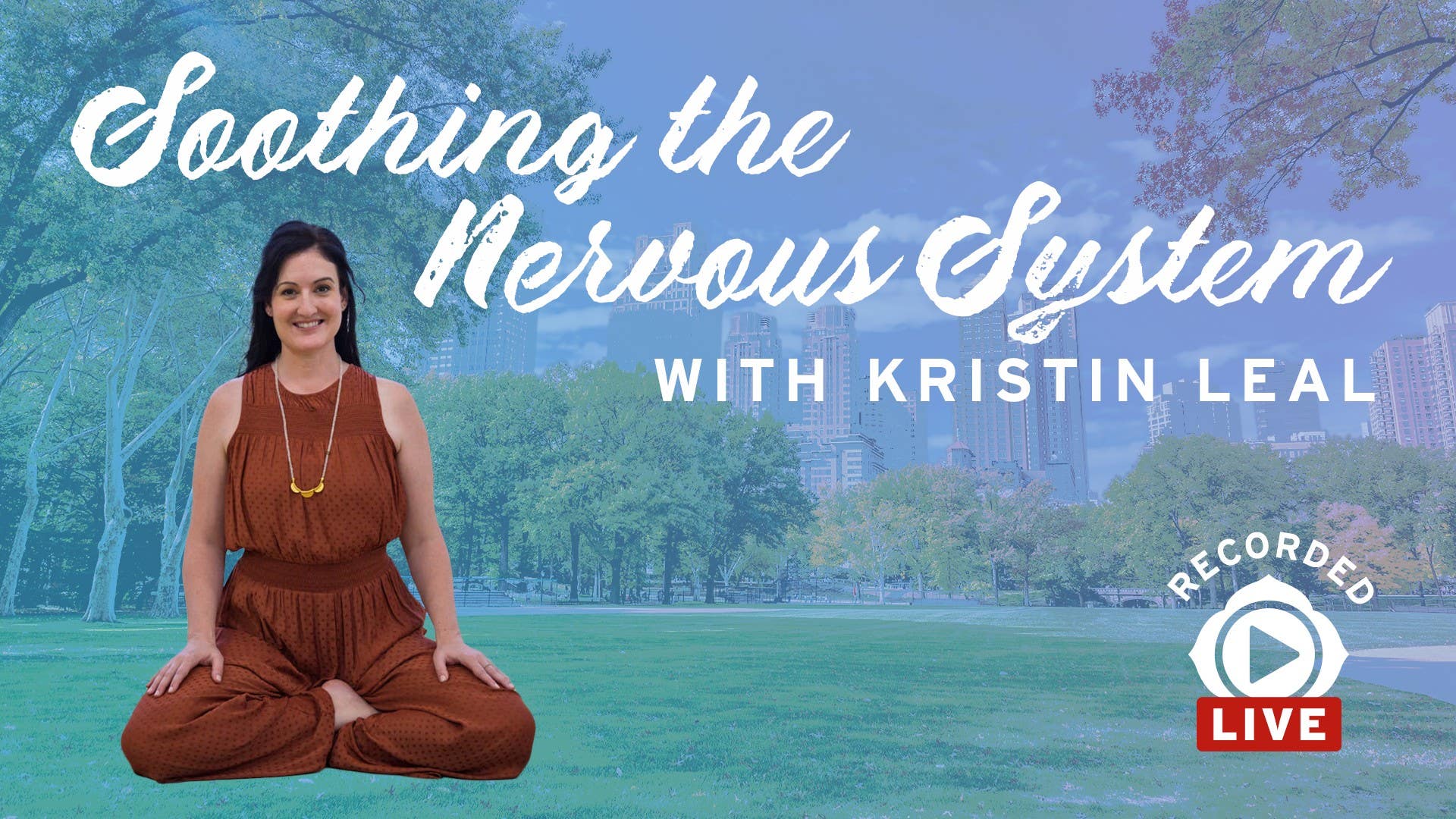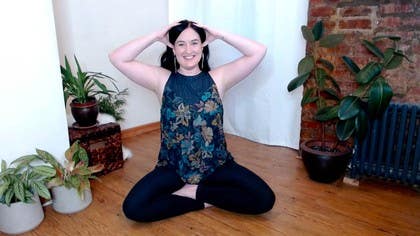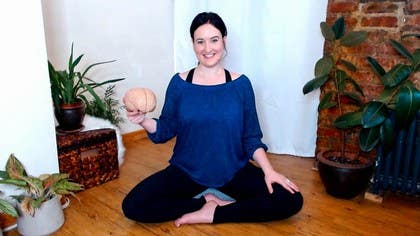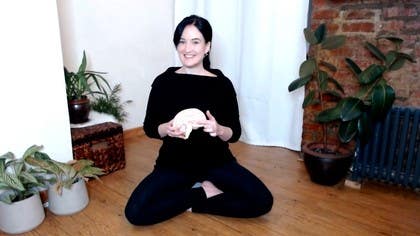Description
Soften into your inherent state of Love. We begin with centering breathing techniques, and enjoy an animated talk on the Vagus Nerve, which monitors the Parasympathetic response. Then Kristin guides us into a seated practice using various tools to help us become more masterful of our restful Vagal Tone. You will feel a sense of well-being and harmony with self.
You can follow along with the Grounding Mantras at the end of each class by accessing the PDF attached below.
About This Video
Transcript
Read Full Transcript
Namaste. All right, so let's come into the most comfortable seated position that will work for you for just a few moments. I think it's nice to start with some breathing. Right now, most likely your breath is a little shallow and not thought of, not cared for in this moment when we don't really need to give it much thought. So I'd like to just spend a few moments deepening the breath, letting it linger, kind of luxuriate in the body so we can really ground present where we are.
So take yourself into the most comfortable seat that you can arrange. I like starting with the palms face down if I did a little bit more grounding, do what you feel resonates with you. And as you're absolutely ready, you can close your eyes, just taking the time to transition, kind of climbing into this moment, this body, and climbing into this breath in its natural state. And maybe just begin with just an awareness of where you feel the density of the presence of your breath to begin. I promise there's no right or wrong answer to that, just noting maybe you feel it in the nose, nostrils, you might feel it in the chest or the belly, back body, who knows you might feel it in your toes, just see if you can find the presence of your breath and your body in this very unique moment of right now.
And then just gradually I'm going to tug a bit on the ends of the breath and purposefully lengthening and slowing down each inhale and exhale. As you begin to move toward that more purposeful thought of cared for breath, you can start to follow its movements as it kind of slides in, unwinds, unfurls, reaches into different little nooks and crannies in the body. Sometimes I like to give it a little bit of an image, like it has a color to it, almost like today it's like a rose gold mist, if you can follow that color, whatever your color is as it moves in with the breath, as if it's painting the inside of the body, you can follow it as it moves through the nose, maybe down through the larynx, throat, lungs, into the chest and back out. As you keep purposefully playing with tugging on the ends of the breath, creating that longer, more full, gentle breath, maybe feel it start to move down from the nose to the chest, even into the belly and moving back out from the belly chest, out through the nose. There's no need to strain, just kind of playing with lengthening and slowing down the breath.
Continue on just a few moments longer, maybe even feel the depth of the breath kind of reach all the way down into the bowl of the pelvis and slides back up on the exhale, pelvis, belly, chest, nose. As you find a kind of a depth of the breath that you haven't yet touched today, it starts to grow really exaggerated, more parts of the body have to kind of get involved to make way or to soften to its caress, so you might even notice just organically a little bit more movements happening in the body. See if you can feel just with the depth of the breath that the inhale makes the pubic bone, the front part of the bowl of the pelvis, heavy. As the breath is rising, you almost start to take a little bit of a back bend shape, almost like a little micro cow pose, and as you slowly exhale and you feel kind of the rise of the belly, pelvic floor, feel the softening of the ribs, there's almost a bowing of the head, and you feel almost like a little micro cat pose, a little rounding as your tailbone gets heavier into whatever you're sitting on. Just do that a few times, kind of exaggerating the breath so much that quite organically a little bit of movement starts to occur, like a tiny little cow pose as you inhale, and a tiny little cat pose as you exhale, and let's kind of go with that as we do a few more and maybe exaggerate the movement a little bit so it becomes not a micro cow and cat, but a macro cow and cat, just a big regular sized cow cat, but still really born from the expression of your breath, and keep your eyes closed, it really doesn't matter what it looks like, and one of those cool times that there's no right or wrong, just exploring the breath and how it moves your body.
And let's just get really crazy. Let's take a bit of a circle with the ribs, so let these cat cows kind of turn into a circular cat cow, again I'm totally just making it up so it doesn't really matter what it looks like, but you can circle your ribs and your torso to the right and back behind you, to the left, and forward, and just letting the rest of the body kind of fall along. Whatever feels good, just a little bit of movement, still inspired by the breath. If you are doing these circles you can try to circle the other side, if you're like me you'll hear little creaks and cracks in the body, just bringing some fluidity in. Finish the circle that you're on and then just start to wind down into a neutral spine of our starting position, and then relax the breath so you no longer have to stretch or shape it or fuss with it at all.
Just take like 30 seconds or so to observe whatever there is there to observe in the stillness, just the resonance of movement of breath in your body. And then just draw your head towards the heart, just dropping your chin towards your chest. And taking your time to flutter your eyes open, just maybe a hazy gaze at one point on the floor, taking your time to come back into the space, our space together. Alright, always better after a little movement. In our last few practices we've been looking a lot at the autonomic nervous system, so the sympathetic and the parasympathetic branches of your nervous system, and how in a perfect world, good luck, but in a perfect world we are meant to be moving quite peacefully back and forth between sympathetic activation and parasympathetic activation.
In a perfect world, every 88 or so minutes, you favor one and you move peacefully back and forth between that all day long, all night long. And that helps to foster a balanced system where you can be both engaged when needed and relaxed when needed, restful when needed. That's in a perfect world, but you know, life. And that impacts and hacks the system, making us hyper-reactive to one or stuck in one more than the other. And a lot of the practices, the yoga practices, will allow us to hack into the autonomic nervous system to bring about either a more desired state, like if we're in that restful state but we need to engage, right, we have access to plug into that part of our nervous system, or if we're super engaged and we need to rest, it gives us access to plug in to that part of our nervous system when desirable.
It also allows us to become, I'm pretty sure I made this phrase up, I make up a lot of phrases, so I think I made this phrase up, but you become autonomically flexible. You know, like we talk quite a lot about in yoga, how we're trying to create more flexibility in our muscles or in our movement. And I think what's even more interesting and perhaps a little bit more useful, I'll say it a lot more useful, is to become autonomically flexible, where we can move back to the sweet balance when we can interact and plug in purposefully to one aspect or the other. And one of the main tools, there's a lot of yoga tools that help us do that, but what we're really mainly interacting with is quite a famous nerve, where it's got a really good press agent, it's getting a lot of press, and that nerve is called the vagus nerve. And it's not like Las Vegas, it's not spelled that way, but V-A-G-U as vagus, it comes from that same root as vagabond.
So it's called the wanderer, right, it's a wandering nerve. It's actually a pair of nerves, even that's talked about in the singular. It's a pair of cranial nerves, so it exits out through the base of the brain, two nerves, and those begin to wander kind of throughout the torso, hitting all of the major organs. And the vagus nerve, it's kind of claimed to fame as being a big output of our parasympathetic tone. So its main job is to elicit and foster that parasympathetic, that housekeeping activities, the restful branch of our nervous system.
And a lot of things we're doing in yoga are purposefully kind of stimulating the vagus nerve, and a lot of the things that we're going to do in this practice will be a purposeful way of stimulating the vagus nerve. And why this becomes really important is you might have heard something called heart rate variability or vagal tone, again getting a lot of press these days. What that's referring to is every time you inhale, your heartbeat speeds up a little bit. There's a nerve that goes to the heart that's called the cardiac sympathetic nerve that when you inhale, the heartbeat revs up. Not this fast, I'm just doing it as an example, thank goodness.
Every time you exhale, there's another nerve, the vagus nerve that goes to the heart that when you exhale, the heartbeat slows down. Not that slow, but for example, so you inhale, revs up, you exhale, it slows down. The difference between those two numbers, how fast it speeds up, how slow it slows down, the difference between those two numbers is what's referred to as heart rate variability or your vagal tone. Now if you've got a great big difference between those numbers, that's called a high vagal tone and that's been linked to people that report, whatever's happening in the world, they report to be able to deal with stress better. They have less anxiety and depression, less obesity and heart disease, lower cholesterol.
They report to feel more supported and to feel more content, the higher the vagal tone. Those that have a lower, not so much of a difference between those numbers, a lower vagal tone will report with all that kind of reverse of that. They report feeling less supported. They have higher incidences of depression and anxiety, obesity, higher blood pressure, waist to hip ratio tends to be larger and so these two tend to be linked somehow. A lot of the things that we're doing in yoga practice, that big capital Y yoga practice that includes all the good stuff of asana, pranayam, breathing techniques, meditation, sound, all different aspects of the yoga practice, even sangha, even being together and thinking about these things and kind of rolling these things over in the mind, those tend to help us increase our vagal tone.
It tends to play with our system in a way to let us be more autonomically masterful, more autonomically flexible where we can plug in to the one that we need sympathetic or parasympathetic and ideally moving back to a really harmonious swing. What's also super cool about the vagus nerve is that nerves tend to be kind of two-way streets. It sends information, the brain kind of sends information to the organs, going do this, do that, tells it kind of as like a little dictator. And then there's also another road back from the organs to the brain that kind of tells the brain how the organ is doing, how it is down there. 80 to 90% of the fibers in the vagus nerve are moving from the organs to the brain.
So much disproportionate, much more information is going from the organs to the brain than the brain to the organs, which is also kind of fascinating. And those signals, any kind of nervous system signals, it's like an electrical signal, almost like Morse code, it has a different kind of pattern. And the signals, when you are feeling things that we might be considering positive emotions, joy, contentment, love, those signals tend to be very cohesive. They tend to be very organized. When you're feeling things that are maybe what we would consider negative, disconnected, not feeling good, those signals actually tend to be more disorganized and discordant, almost like when you get to the orchestra early and you hear all the instruments playing and there's like a tuba and a timpani and there's just all playing at weird times.
Yoga tends to help us, almost like the conductor coming in and banging his baton on the music stand and kind of calling everyone back into harmony, calling everyone back, orchestrating kind of more harmony and that's what helps us. Yoga practices help us have a return back to those more organized harmonic signals back from the heart to the brain, it helps to move us back to that inherent state that is what yoga would consider love or joy or contentment or birthright. So there's some specific ways that we're going to use in our practice today to help bring us back into that state to trigger the vagus nerve and to make us more autonomically flexible. One is sound, we're going to use almost like the M sound of om, the mmm vibration, made audibly if you're in a space where you can do that. And we'll use a hand technique, a mudra, where don't do it yet because you won't be able to hear me, but you're going to bring your thumbs into your ears and you can press that little flesh that's in front of the ear canal in and you're going to take the other fingers lightly on the head, this will just help you tune to that sound and we'll make that sound a few times together to begin, that said to be helpful to trigger the vagus nerve.
We'll also work with deepening the breath, deepening the breath on its own can help to trigger a vagal response. We're going to play with, especially playing with extending the exhale phase, making that longer than the inhale, we're doing some breath ratio work in our pranayama practice. So this can be taken at your own pace, I'm going to call out some suggestions, but if you're feeling like you're gulping or struggling for the breath, it's not worth it. And please go back a stage or come back to a slightly shorter breath or pause, recollect your breath and then come back to the technique as many times as you need, it's no problem with that. But playing with the exhale phase of the breath longer than the inhale can help trigger more of that vagal response, which can help again, make us a little bit more flexible.
We'll also do some holds, what's called in yoga terminology, kumbhaka or retention. There's a really beautiful story about where that might have come from in the yoga tradition. You know, if you think of, you know, the last time you saw a really beautiful sunset or you saw the person that you love or the animal that you love and they took your breath away, you just spontaneously, like that pause that spontaneously occurs when you're in awe, when you're in love. And so one of the stories being that the yogis of old tried to reverse engineer that by playing with the pauses after the inhale or the pauses after the exhale to capture that state. And I think that's the energy which we want to attempt or interact with these retentions.
If you do a retention and it's constipated, that's a whole different energy, right? But if we do a retention that's more about just suspending in that place of awe or love, this might be maybe what the yogis were trying to get at. But those pauses in anatomical language can help elicit a little bit more flexibility in the autonomic nervous system. When we attempt the Bandhas or retention, which we also might do, Bandha being just a little muscular action in those pauses that I'll talk you through, that also can help make us a little bit more flexible. All of this can be done under your own comfort or within your own comfort.
So please take things as they come and feel free to pause at any time and come back to it as you're ready. No need to strain through this at all, I promise, okay? That being said, shake your legs out if you need to, and we're going to organize our bodies so that they can be seated for the next, it could be about 20 minutes, 25 minutes. So you want to make sure that you do set up well, almost like a, create a little throne for yourself so that you don't have to think too much about your body. I'll even readjust my scene.
Okay. All right, as you're ready, find what works for you always, draw your spine up a bit taller just so you have more, like a more welcoming vessel for the breath. Again, we'll start with the palms face down just to arrive, and when you're absolutely ready to, you'll close your eyes and just landing in this new moment, in this new body, and in this new breath. As you're ready, we'll just start deepening the breath again. No particular agenda, don't worry about the count, just welcoming the breath a little bit deeper, maybe lower into the belly, pelvis, might even feel the breath moving down into the basement of the pelvis, the pelvic floor region, the area between the pubic bone and tailbone.
And we're going to begin to move towards, sometimes it's referred to as bromary, that sound of M, that M sound. We're going to do that together about three times slowly, I'll talk you through it. As you're ready, you can keep your eyes closed and take your hands up, placing your thumbs kind of on that little triangle of flesh in front of the ear canal, gently pressing it in, closing off your ears, other fingers lightly on top of your head, elbows out to the sides. You can soften the muscles of the face, jaw, tongue, forehead, you can take a nice slow breath in, with your long exhale we'll make that M sound together, inhaling, inhaling, inhaling, inhaling, inhaling. One more time, inhaling, keeping your eyes closed you can lower the hands back down onto your knees, just experience or feel whatever that brought, continue to deepen the breath in and out through the nose, and just start to build to a long, slow inhale and exhale, just a depth to your capacity, so it does take a little bit of effort, you can apply a very soft ujjayi, just a very kind of little hug of the vocal folds, just so you savor the breath, you can slow it down, you can regulate it, might also start to take on a quality of vibration or sound from the throat, almost like you're whispering very quietly, no strength.
Continue deepening the breath until you can find the comfortable limit of your breath. You're going to mentally begin to count on the inhale and on the exhale, so mentally as you inhale count to eight, so you're inhaling for eight counts, now whatever that is for you, it could be fast count, it could be a slow count, just inhale for eight, feel it climb all the way up under the collar bones, whole body participating, and then exhale for 12 counts, so you'll have to slow down the exhale, trying to exhale for 12 counts, just do the best you can, again no force, we're going to do that a few times, you're going to inhale for eight, you'll all have different capacity and pace, so you'll do this on your own, you'll inhale for eight and exhale for 12, to the best of your ability, you can feel as you're really trying to exhale all the way out for 12 counts, you might feel the pelvic floor in the belly get a little bit more involved, getting a little bit more lifting, inhaling for eight, as you inhale you can feel the body get a little more involved, spine gets longer, collar bones lift, you can even bring your chin just a little bit inward at the height of the inhale, almost like you're creating a baby double chin that just helps give you access to more of your lungs, exhaling for 12, as you find the very bottom of that exhale you might notice the pelvic floor and belly lift slightly in and up, please continue inhaling for eight, exhaling for 12, one or two more rounds. Again anytime you need a little recovery breath, please take it and just return back when you're ready, in for eight, out for 12. You're gonna change it up slightly, you're gonna inhale next time for eight, at the very height of the inhale lift the collar bones, bring your chin just slightly in and back and pause at the height of the inhale for two counts, so you're inhaling for eight and then pause for two and the mind just falling into the heart and then you'll exhale for 12, we'll do that a few times. On your own you'll inhale for eight, at the top of the inhale creating just a little baby double chin, a little jalandara bandha, pause for two and slowly then lift your chin, release the chest, belly, exhaling for 12.
The bottom of the exhale to really let yourself empty, you might lift the pelvic floor and belly slightly in and up, okay just a couple more times like that, in for eight, pause, suspend for two and then out for 12, just do the best you can. Alright, that's it for this video, thank you so much for watching, see you next time, bye bye. We're gonna change it slightly again, next time you inhale you're gonna inhale for eight and then just pause at the height of the inhale for four counts, in for eight, pause, suspend for four counts and then exhale for 12, go to the very bottom of your exhale, inhale for eight, bring your chin slightly in and back at the height of the inhale, pause for four, mind falling towards the heart, towards that space of awe, love, you'll lift your chin and exhale for 12. Let's continue just a couple more rounds, in eight, pause, four, out 12. One, two, three, four, five, six, seven, eight, nine, eight, nine, eight, nine, eight, nine, eight, nine, eight.
Now, next inhale we're gonna inhale for eight, top of the inhale pause for six counts, mind in the heart, then exhale for 12. So you'll inhale for 8, pause for 6, little Jalandharabhandha. Then you'll lift your chin and you'll exhale slowly for 12 counts. Now if the pause is making you anxious or you're struggling or kind of gasping for the breath, move back to retaining for 4 or 2 or drop the retention. Just continue on a few more rounds in for 8. Suspend for 6, the height of the inhale and then out for 12. A few more times. Now we'll very slowly begin to decrease the amount of the retention. So next inhale, inhale for 8, hold just for 4 and exhale for 12. So you're inhaling for 8, pausing just for 4 and exhaling for 12. A few rounds. Now you're inhaling for 14. So you're inhaling for 14. So you're inhaling for 14. So you're inhaling for 14. So you're inhaling for 14. So you're inhaling for 14. So you're inhaling for 14. Now the next round, inhale for 8, pause for 2, exhale for 12. A few times. Now you're inhaling for 14. So you're inhaling for 14. So you're inhaling for 14. So you're inhaling for 14. So you're inhaling for 14. So you're inhaling for 14. So you're inhaling for 14. Now lastly, your next round, inhale for 8, exhale for 12, no retention. Just inhaling for 8, exhaling for 12. A few times. So you're inhaling for 14. So you're inhaling for 14. So you're inhaling for 14. So you're inhaling for 14. Now finish the round of breath that you're on now. And then relax the breath.
No longer having to count it or shape it or stretch it. Just let it move back into its unfussed with version, quiet, most likely shallow. And sit for just a minute or two to notice whatever there is there, whether it's sensation in the body, quality of your energy, mind, motion. Just observe for just a couple of minutes. So you're inhaling for 14. So you're inhaling for 14. So you're inhaling for 14. So you're inhaling for 14. So you're inhaling for 14. So you're inhaling for 14. So you're inhaling for 15. So you're inhaling for 14. So you're inhaling for 14. So you're inhaling for 14. And let's bring the chin down to the chest. And allow the eyes to softly flutter open. Just a hazy gaze at one point. It's important to rest for a few moments, a few minutes after some breath work or pranayama. So find a place where you can come down onto your backs and set yourself up in a shavasana-like position. Support yourself if you need or desire a pillow under your knees, something under your head or blanket on top of you. Just rest for just a few minutes in shavasana to let your body adjust, to rebalance, hopefully allowing you to come back into that more harmonious, organized, flexible state, that inherent state of love. Getting comfortable in shavasana, closing your eyes.
Take a minute to begin. Thank you. Thank you. Thank you. Thank you.
Thank you. Thank you. Thank you. Thank you. Thank you.
If you have any questions, feel free to ask them. If you have any questions, feel free to ask them. Feel an aspect of the breath move down through the limbs animating your fingers and your toes. Slide your tongue across your teeth and then press your tongue to the roof of your mouth. It might feel good to reach your arms overhead and give yourself a moment to stretch in some way.
Take your time as you're ready, bending one knee at a time, placing your feet on the floor or the bolster. As you're ready, just roll over to one side, whatever side makes more sense and just curl up in a fetal position to make a little pillow with your arm for your head. As you stay there a few more moments, just note any qualities, any piece of the practice that you'd like to take with you into your day. Keeping your eyes closed, use your hands to help you just lazily bring yourself back into a comfortable seat. Take your palms together in front of you and just rub your palms together just to help ground after a nice long practice.
Draw your tongue forward behind the upper teeth to the gum line and then separate your palms just an inch or so apart. Just feeling a sense of heat, maybe electricity, what we might term prana. You can draw your hands another inch or so apart and feel beyond that heat. There's a puffy feeling, a radiance. Separate them a little bit further and feel that you can stretch or shape or press that sensation between the palms. You can place your palms, hands over your closed eyes and feel a sense of that heat or prana begin to bathe the eyes, the brain, face.
You can slide your hands down the sides of your feet. Give your shoulders a little massage. And then taking one hand over the other hand, over the throat, just feeling a sense of that heat bathe the structures of the throat and your speech. Taking the hand, sliding them down over the heart, returning to the heart. And then bowing to your true teacher, your inner teacher in Sanskrit, it's the same as the same as the same as the same.
Soothing the Nervous System
Comments
You need to be a subscriber to post a comment.
Please Log In or Create an Account to start your free trial.















